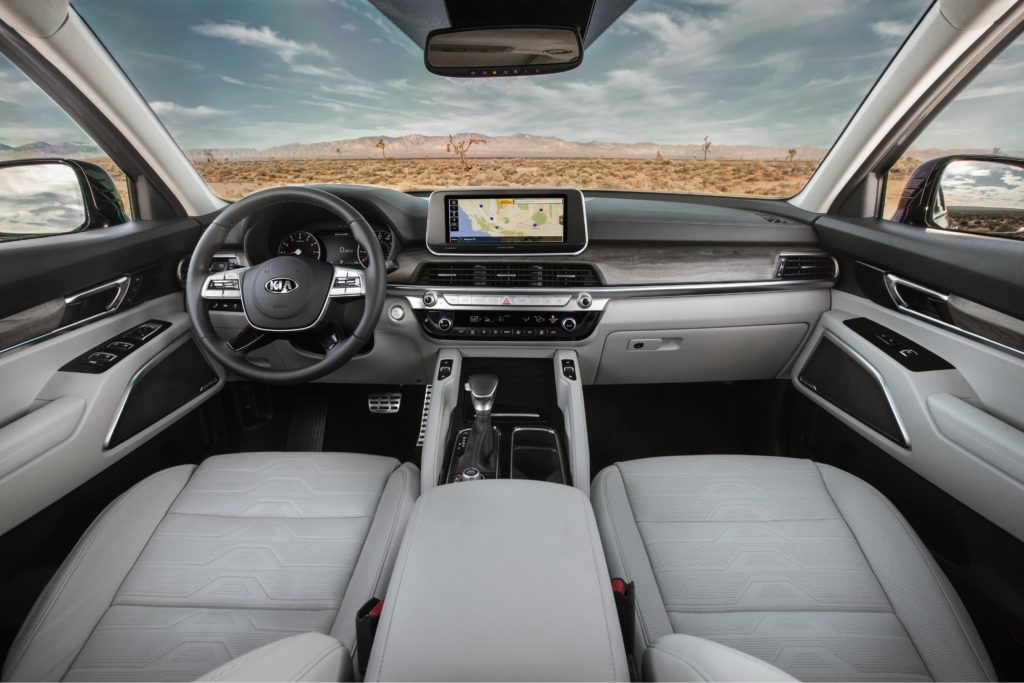
Parked side-by-side in my garage were two all-new midsize SUV crossovers – the 2020 Kia Telluride SX and ’19 Chevrolet Blazer Premier.
They’ll compete for sales success with more than a dozen other midsizers, including the redesigned Honda Passport, the new Subaru Ascent and the long-popular Jeep Grand Cherokee.
A first glance makes separation of the two as simple as black and white, dark graphite metallic for the Chevrolet and snow-white pearl for the Kia.
The two are near identically shaped at the rear, with lip of a spoiler atop the rear window. The distinguishing differences from the rear are the taillights – the Blazer’s horizontal and the Telluride’s vertical, and a “floating-roof” look for the Chev. Up front, the Blazer has more of a rake to its windshield, the Telluride stands taller and step-in height is the same for both at about 19 inches. The Blazer rides on 21-inch wheels, the Telluride 20.
The Telluride, the largest model ever offered by Kia, was unveiled at the Detroit Auto Show in January 2019. It has three rows of seats, and is considerably larger than the established Kia Sorento, which has been considered a “small midsize entry.”

The Telluride, 5 inches longer than the Chevy Blazer, is 196.9 inches in overall length, 78.3 in width and 68.9 height. Chevy’s dimensions are 191.4 inches in overall length, 76.7 width and 67 height. Difference in curb weight is approximately 100 pounds, the Telluride at 4,317 pounds and the Blazer at 4,210.
The use of the Blazer model name on a Chevrolet is revival of an identification that was first used in 1969 on full-sized SUVs on a truck chassis known as the K5 Blazer. The compact S10 Blazer was added in 1982; both were discontinued in 2005. A TrailBlazer model was produced from 2001 to 2009.
A 292-horsepower, direct-injection 3.8-liter V-6 engine with 262 lb.-ft. of torque is tied to an 8-speed automatic transmission for the Kia. Performance gets a bit of boost in Sport mode, and passing power is more than adequate out on the highway. Properly equipped, the Telluride can tow up to 5,000 pounds.

The Chevy seems more responsive in low-end-rpm situations with its 308-hp, 3.6-liter V-6 (270 lb.-ft of torque) and paddle shifters to spur its 9-speed automatic transmission. Tow capacity for the Blazer is 4,500 pounds.
The Chevy carries a slight advantage in EPA highway fuel-mileage estimates, 25 to 24, but in my week while driving back-and-forth between the two, the Kia posted a bit higher averages than did the Chevy. Overall, it was 22.9 mpg for the Telluride and 21.9 for the Blazer.
The Kia sport ute has 21 cubic feet of cargo space behind its third row of seats; fold down the back row and it expands to 46 cubic feet. The Blazer has 30.5 cubic feet behind its second row. Approach the rear of the Chevy with key in pocket at night and the Chevy bow-tie emblem is cast on the ground beneath the bumper; swing a foot over the emblem and the liftgate automatically opens.
The loaded-up, all-wheel-drive models are close in price; the Blazer at $49,290 and the Telluride at $47,255, including forward-collision avoidance alert and lane-keeping assist. The Blazer tag would have pushed past $50,000 with optional forward collision warning, automatic emergency braking and lane-keep assist. Apple CarPlay and Android Auto are standard on the Chevy.
The Kia is built in West Point, Ga.; the Chevy Blazer in Ramos Arizpe, Mexico.